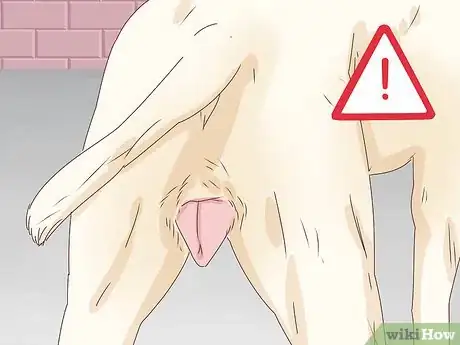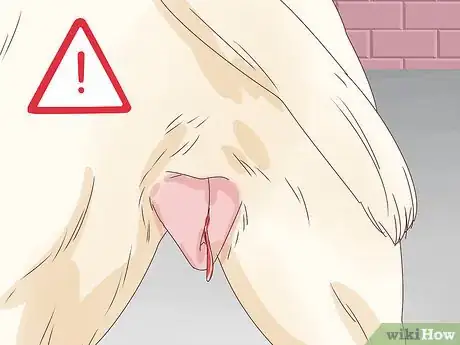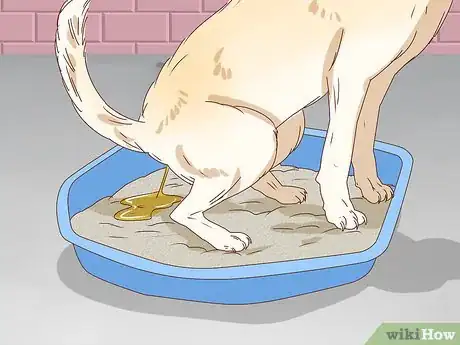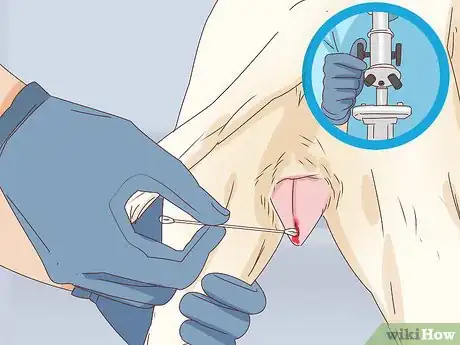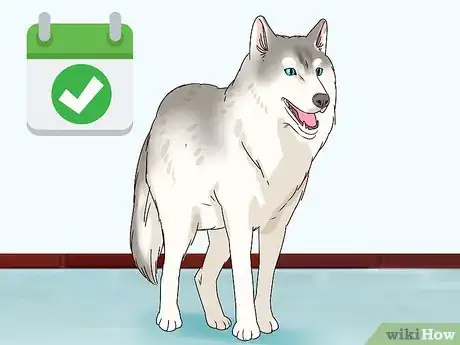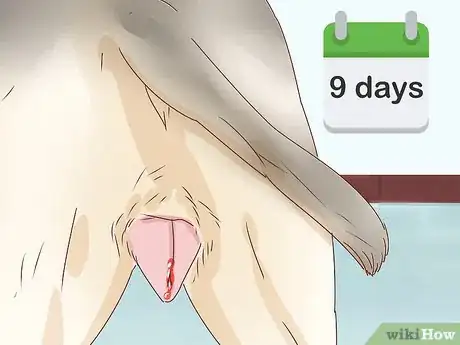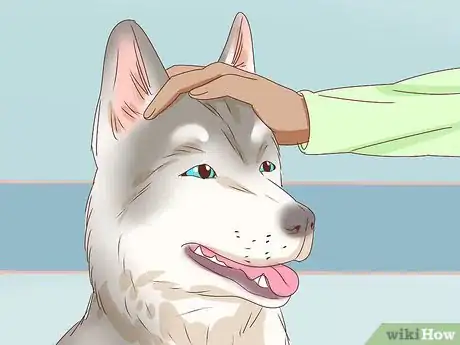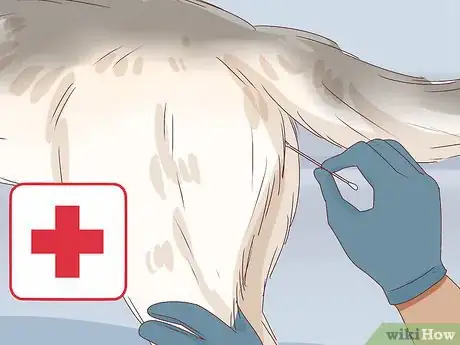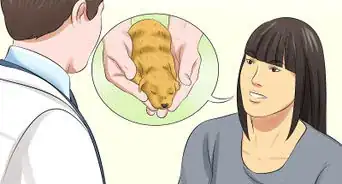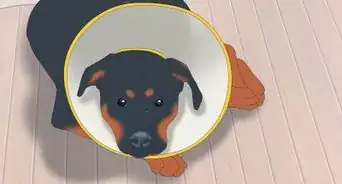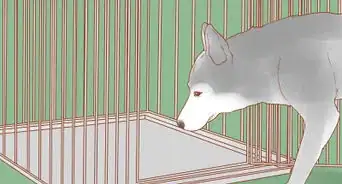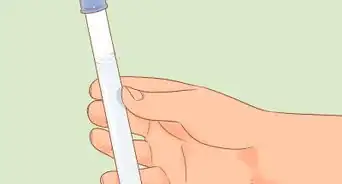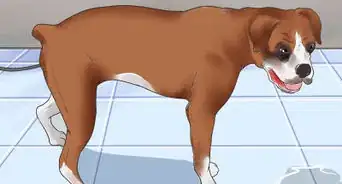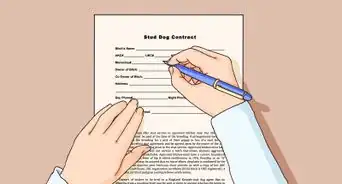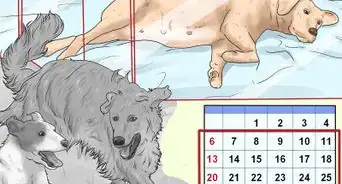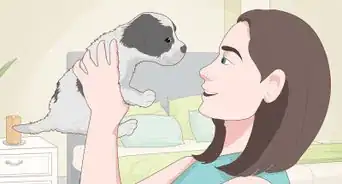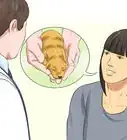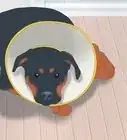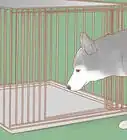This article was co-authored by Tom Robertson. Tom Robertson is a Dog Breeding Specialist and the Owner of Prize Poodles and Doodles. With over 20 years of experience, he specializes in breeding doodles. Tom has also received additional educational training in dog grooming, boarding, and training.
This article has been viewed 60,523 times.
If you know you want to breed your dog, you will need to be able to spot signs that she is fertile and ready to mate. This will require you to recognize both the physical and behavioral changes that occur when a female dog becomes fertile, also known as going into heat.[1] With some close observation, you should be able to assess when your dog is ready for breeding. However, if you have tried to mate her and it has been unsuccessful, you will need to assess her health more closely by looking for issues that could be impacting her fertility.
Steps
Identifying Signs That Your Dog is Fertile
-
1Look for swelling of the vulva. When the dog is reaching her fertile phase, known as estrus or heat, her vulva will begin to swell.[2] This can be seen on the outside of her body if you look at the area directly below her anus.[3]
- The vulva will be puffy and will appear red in color. By the time she is in full heat, the vulva will swell to about three times its normal size.
-
2Spot vaginal bleeding. Along with the vulva swelling, she will also have bloody discharge coming out of her vagina.[4] [5] This discharge begins before the dog is fertile and lasts until after she has ovulated and is no longer fertile.
- Vaginal bleeding usually starts a week or so before the dog actually ovulates.
- Sometimes it is hard to spot the vaginal bleeding because the dog cleans herself quickly and does not allow it to become evident. In cases such as this, you should look for increased licking.
-
3Watch for increased urination. During her fertile period, a female dog may urinate more than usual. This is a sign that her hormone levels are changing and that she may be ready to mate.[6]
- The urine passed by a female dog in heat contains pheromones that signals to male dogs that she is in heat.
-
4Consider getting your dog tested to determine when she is fertile. There are tests that can be used to identify when a female dog is fertile and ready to mate.[7] These can be done by veterinarians at their veterinary practices.[8]
- One test is a vaginal cytology test. This is a non-invasive vaginal smear test that examines vaginal cells to look for changes associated with ovulation. To assess when your dog is fertile it may take several tries.
- The other test is a serum progesterone test. This is a blood test that looks at progesterone levels. It is very accurate and popular but does require that your dog's blood be drawn.[9]
Identifying Infertility Issues
-
1Make sure the dog is old enough to reproduce. A female dog usually becomes fertile for the first time after she is six months old. However, she should not be bred during her first estrus. Since heat usually occurs every six months approximately, this means that she should be at least a year old when she is bred.[10]
- The age of sexual maturity will vary a lot depending on the specific dog and what breed she is. In general, smaller dogs tend to reach sexual maturity sooner than larger dogs.
-
2Track your dog's reproductive cycle to spot problems. Signs that your dog may have infertility issues include problems with an irregular cycle. Track your dog's reproductive cycle to help identify a potential issue. A dog's reproductive cycle includes four phases:
- Proestrus: In this phase the female dog attracts males, has bloody vaginal discharge, and her vulva is swollen. She will not allow breeding during this phase, which lasts approximately nine days.
- Estrus: During this period the dog is fertile and she will allow mating. It usually lasts for about nine days but ovulation usually occurs in the first 48 hours.
- Diestrus: Diestrus is the sixty to ninety day period when the dog is no longer fertile but discharge may continue. This occurs whether or not the dog becomes pregnant.
- Anestrus: Anestrus usually lasts three to four months and no sexual activity takes place during this phase.
-
3Make sure your dog can physically copulate. If your dog is having a hard time mating, it could lead to an inability to reproduce. This is a physical issue that could be caused by injury and by a misalignment between the female and male dog.
- In order to assess your dog's physical ability to copulate, you may need to talk it to a veterinarian or an expert in dog breeding. They should be able to assess your dog's physical reproductive issues.
- If the dogs you are trying to mate are having a hard time completing the act, then you may need to step in and help. In extreme cases, you may even need to have your female dog artificially inseminated if she and the male dog cannot physically fit together.[11]
-
4Assess behavioral factors. There may just be issues with your dog's comfort or interest in sexual intercourse due to where you are trying to dog the mating. Make sure your dog is comfortable and well cared for before mating. Sometimes copulation does not occur because the dog is inhibited in its usual environment.[12]
- Try taking your female dog out of its normal area and having it mate at the male dog's location. This could help her to become less inhibited.
-
5Have your dog looked at by a veterinarian. If you are having a hard time breeding your dog and you have exhausted all other avenues for promoting fertility, then you should get a medical opinion. Your veterinarian should be able to assess your dog's health and look for issues that may be impacting your dog's fertility.
- Problems impacting fertility could include a wide variety of issues, including hormonal imbalances, physical abnormalities, or reproductive tumors or infections.
Expert Q&A
-
QuestionHow do I care for my dog after giving birth?
 Tom RobertsonTom Robertson is a Dog Breeding Specialist and the Owner of Prize Poodles and Doodles. With over 20 years of experience, he specializes in breeding doodles. Tom has also received additional educational training in dog grooming, boarding, and training.
Tom RobertsonTom Robertson is a Dog Breeding Specialist and the Owner of Prize Poodles and Doodles. With over 20 years of experience, he specializes in breeding doodles. Tom has also received additional educational training in dog grooming, boarding, and training.
Dog Breeding Specialist Always keep your puppies' environment really clean after birth. Be sure to groom the mother on occasion as well. You can also trim the puppies' nails as they tend to irritate the mom's nipples.
Always keep your puppies' environment really clean after birth. Be sure to groom the mother on occasion as well. You can also trim the puppies' nails as they tend to irritate the mom's nipples. -
QuestionHow do you clean up after a litter of puppies?
 Tom RobertsonTom Robertson is a Dog Breeding Specialist and the Owner of Prize Poodles and Doodles. With over 20 years of experience, he specializes in breeding doodles. Tom has also received additional educational training in dog grooming, boarding, and training.
Tom RobertsonTom Robertson is a Dog Breeding Specialist and the Owner of Prize Poodles and Doodles. With over 20 years of experience, he specializes in breeding doodles. Tom has also received additional educational training in dog grooming, boarding, and training.
Dog Breeding Specialist You have to clean the whelping box constantly. If you'd like you can clean it with diluted bleach products, but I strongly recommend the usage of products that are specifically labeled as "safe for dogs", just to be sure.
You have to clean the whelping box constantly. If you'd like you can clean it with diluted bleach products, but I strongly recommend the usage of products that are specifically labeled as "safe for dogs", just to be sure.
References
- ↑ http://www.akc.org/content/dog-care/articles/how-long-are-dogs-in-heat/
- ↑ Tom Robertson. Dog Breeding Specialist. Expert Interview. 5 April 2022.
- ↑ http://www.banfield.com/pet-health-resources/pet-health-concerns/reproduction/is-my-dog-in-heat
- ↑ http://www.vcahospitals.com/main/pet-health-information/article/animal-health/breeding-for-pet-owners-estrus-and-mating-in-dogs/484
- ↑ Tom Robertson. Dog Breeding Specialist. Expert Interview. 5 April 2022.
- ↑ http://www.vcahospitals.com/main/pet-health-information/article/animal-health/breeding-for-pet-owners-estrus-and-mating-in-dogs/484
- ↑ Tom Robertson. Dog Breeding Specialist. Expert Interview. 5 April 2022.
- ↑ http://www.vcahospitals.com/main/pet-health-information/article/animal-health/breeding-for-pet-owners-estrus-and-mating-in-dogs/484
- ↑ Tom Robertson. Dog Breeding Specialist. Expert Interview. 5 April 2022.
About This Article
To know if a female dog is fertile, look at the area just below its anus to see if the vulva is swollen, since this area appears red and swells when a dog is in heat. Additionally, check for vaginal bleeding or increased licking, which are other signs of fertility. Also, note if your dog is urinating more frequently, which could be a sign of fertility. If you're still unsure, take your dog to the vet for a vaginal cytology test or serum progesterone test to confirm your dog's fertility. For tips on how to spot common infertility issues, keep reading!
